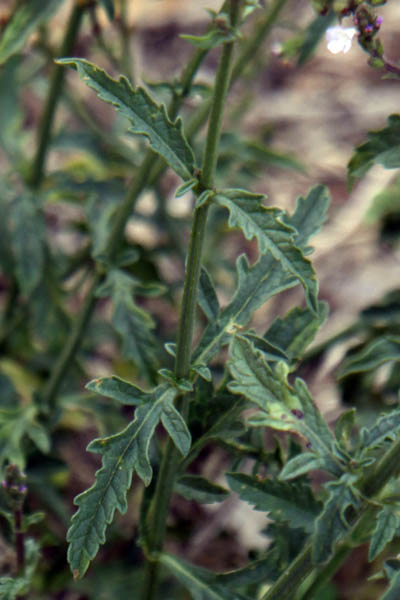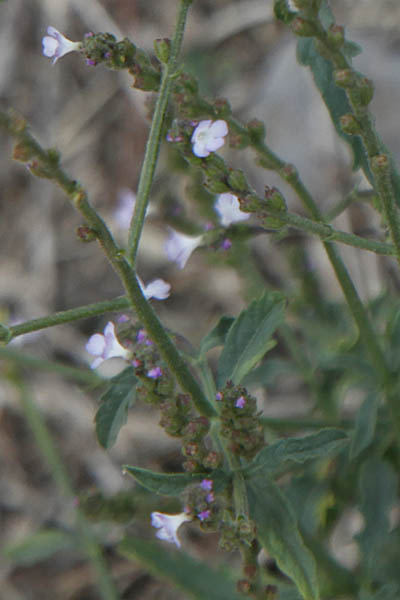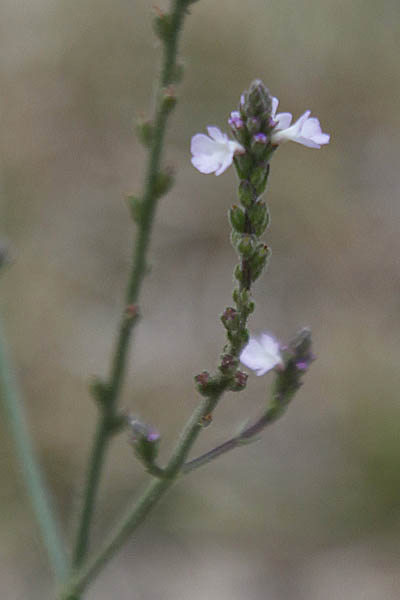Common Verbena, Common Vervain, Simpler's Joy, Holy Herb,
Hebrew: ורבנה רפואית, Arabic: رعي الحمام الطبي
| Scientific name: | Verbena officinalis L. | |
| Synonym name: | Verbena domingensis Urb., Verbena macrostachya F.Muell. | |
| Common name: | Common Verbena, Common Vervain, Simpler's Joy, Holy Herb | |
| Hebrew name: | ורבנה רפואית | |
| Arabic name: | رعي الحمام الطبي / rey alhamam altibiyu | |
| Family: | Verbenaceae, Verbena family or Vervain family, ורבניים |

|
| Life form: | Perennial herb, hemicryptophyte | |
| Stems: | Erect quadrangular stem growing to 80 cm tall | |
| Leaves: | Opposite, dissected, pinnate, dentate or serrate, petioles | |
| Flowers: | Tubular pale pink to lilac flower, borne in spikes, hermaphrodite | |
| Fruits / pods: | Separate into 4 individual nutlets | |
| Flowering Period: | May, June, July, August, September, October | |
| Habitat: | Humid habitats | |
| Distribution: | Mediterranean Woodlands and Shrublands, Semi-steppe shrublands, Shrub-steppes, Deserts and extreme deserts, Montane vegetation of Mt. Hermon | |
| Chorotype: | Subtropical -Tropical | |
| Summer shedding: | Perennating |

Derivation of the botanical name: Verbena, an ancient Latin name of the common European vervain. officinalis, derived from opificina, shortened to officina, originally a workshop, later a monastic storeroom, then a herb-store, pharmacy or drug-shop. domingensis, meaning from Dominica, refer to the plants's native habitat. macrostachya, macros μακροϛ long, tall; stachys σταχυϛ spike, ear of corn; large spikes. The Hebrew name: ורבנה, Verbena , transliteration from the scientific name.
Pliny the Elder(23-79 CE), Gaius Plinius Secundus, a Roman historian and author of "Natural History", Book XXV. 109: "No plant however is so renowned among the Romans as hiera botane ("sacred plant"). Some call it asistereon, and Latin writers verbenaca. This is the plant which I mentioned as carried to the enemy by envoys." With this the table of Jupiter is swept, and homes are cleansed and purified". Dioscorides (circa 40—90 CE), in his book Περὶ ὕλης ἰατρικῆς (Greek), De Materia Medica (Latin), recommends 1 drachm (4 g) of ‘Hiera Botane’ or sacred herb Verbena officinalis mixed with half as much frankincense in 1 cotyle (274 mL) of aged wine, taken warm on an empty stomach for 4 days in cases of jaundice. 
|